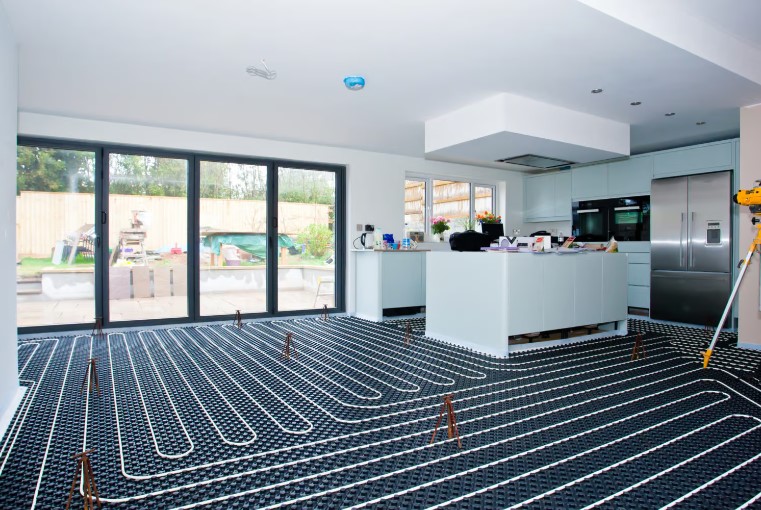
What’s underfloor heating and Cooling and is it worth the money? – Underfloor heating and cooling systems Marbella, also known as radiant floor heating and cooling, is a system that is installed beneath the floor of a building to provide heating or cooling to the indoor space. This system is becoming increasingly popular due to its energy efficiency, comfort, and versatility.
In underfloor heating systems, hot water is circulated through pipes installed beneath the floor. The heat from the water radiates upward, warming the floor and the indoor space above. Similarly, in underfloor cooling systems, cold water is circulated through the pipes to cool the floor and the indoor space.
The benefits of underfloor heating and cooling are numerous. First and foremost, it is an energy-efficient way to heat or cool a building. Radiant heat has a lower air temperature than traditional forced-air heating systems, which means that less energy is needed to maintain a comfortable indoor temperature. Additionally, underfloor systems can be used in combination with renewable energy sources such as solar power, making them even more environmentally friendly.
Another benefit of underfloor heating and cooling is that it provides more even heat distribution. With traditional heating systems, the warm air rises to the ceiling, leaving the lower part of the room cooler. In contrast, underfloor heating radiates heat from the floor up, providing a more consistent and comfortable indoor temperature.
Underfloor heating and cooling systems are also versatile. They can be installed in a variety of buildings, including residential homes, office buildings, and hospitals. They can also be used with a variety of flooring types, including tile, wood, and carpet.
Why types of underfloor heating and cooling is available?
There are two main types of underfloor heating and cooling systems: hydronic (water-based) and electric.
Underfloor heating Costa del Sol – Hydronic underfloor heating and cooling systems use hot or cold water that is circulated through a network of pipes that are installed beneath the floor. The water is heated or cooled using a central boiler or chiller and then circulated through the pipes to provide heating or cooling to the indoor space. This type of system is more commonly used in larger buildings, such as commercial or industrial properties.
Electric underfloor heating and cooling systems, on the other hand, use electric cables or mats that are installed beneath the floor to provide heating or cooling. These systems are typically used in smaller buildings or individual rooms, such as bathrooms or kitchens. Electric systems are easier and less expensive to install than hydronic systems, but they can be more expensive to operate in the long term.
There are also different types of installation methods for underfloor heating and cooling systems. One popular method is to install the pipes or electric cables directly into a concrete floor slab, which is then covered with a finished floor surface. Another method involves installing pipes or cables between the joists of a suspended timber or metal floor. This method is usually used in situations where it is not possible to install the system directly into a concrete slab.
Underfloor heating and cooling systems can be used in conjunction with other heating and cooling systems, such as heat pumps or air conditioning units. This allows for greater flexibility in terms of temperature control and energy efficiency.
How much are underfloor heating and cooling systems?
Underfloor Cooling Costa del Sol – The cost of underfloor heating and cooling systems can vary greatly depending on several factors, such as the size of the building, the type of system, the flooring materials, and the location. In general, hydronic systems tend to be more expensive to install than electric systems due to the need for a boiler or chiller but may be more cost-effective in the long run due to their higher energy efficiency.
For a residential home, the cost of a basic electric underfloor heating system can start at around €40-€50 per square meter of floor space. A more advanced system with smart controls or zoning capabilities can cost upwards of €100 per square meter.
Hydronic systems are typically more expensive to install, with costs starting at around €60-€80 per square meter of floor space. However, the installation cost can increase significantly if additional work is needed to install the necessary pipework or if a boiler or chiller needs to be added to the system.
It’s important to keep in mind that these are rough estimates, and the actual cost will depend on the specific details of the project. It’s recommended to obtain quotes from multiple installers to get a better idea of the actual cost of your project. Additionally, it’s worth considering the long-term energy savings and increased comfort that underfloor heating and cooling can provide, which may outweigh the initial installation cost.
How to install underfloor heating and cooling
The installation of underfloor heating and cooling systems can be a complex process that is best left to professionals. However, here is a general overview of the installation process for hydronic and electric underfloor heating and cooling systems:
- Determine the heating and cooling requirements: The first step is to determine the heating and cooling requirements of the building, such as the required heat output, the desired indoor temperature, and the number of zones or rooms that will be heated or cooled.
- Choose the type of system: Based on the heating and cooling requirements, the type of underfloor heating and cooling system can be chosen, such as hydronic or electric, and the appropriate installation method can be determined.
- Prepare the subfloor: The subfloor must be properly prepared before installation, which may involve levelling, priming, and adding insulation or a damp-proof membrane to prevent heat loss.
- Install the pipes or cables: For hydronic systems, pipes are laid out in a network of loops that are connected to a central boiler or chiller. For electric systems, heating cables or mats are installed in a specific pattern according to the manufacturer’s instructions.
- Connect the system: The pipes or cables are then connected to the heating or cooling source and to the manifold or control panel, which allows for temperature control and distribution to different zones or rooms.
- Cover the pipes or cables: The pipes or cables are then covered with a layer of screed, which provides a level surface for the finished flooring to be installed on top.
- Install the finished flooring: Once the screed has cured, the finished flooring, such as tile, wood, or carpet, can be installed over the top.
- Commission the system: Finally, the system is commissioned by testing and balancing the flow of water or electricity and adjusting the temperature controls to ensure optimal performance and energy efficiency.
It’s important to note that the installation process can vary depending on the specific details of the project and that professional installation is recommended to ensure the system is installed correctly and safely. If you would like any information about underfloor heating and cooling, contact the team, at Solares Energies. We supply, install and maintain underfloor heating systems in Malaga, Spain. Our team of specialists are on hand to advise and help you on your underfloor heating journey.

